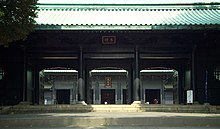Hayashi Gahō
| Hayashi Gahō | |
|---|---|

Hayashi Gahō was head of the early seidō
|
|
| Born | 1618 Kyoto |
| Died | 1688 Edo |
| Occupation | Neo-Confucian scholar, academic, administrator, writer |
| Subject | Japanese history, literature |
| Children | Hayashi Hōkō, son |
| Relatives | Hayashi Razan, father |
Hayashi Gahō (林 鵞峰?, July 21, 1618 – June 1, 1688), also known as Hayashi Shunsai, was a Japanese Neo-Confucian scholar, teacher and administrator in the system of higher education maintained by the Tokugawa bakufu during the Edo period. He was a member of the Hayashi clan of Confucian scholars.
Following in the footsteps of his father, Hayashi Razan, Gahō (formerly Harukatsu) would devote a lifetime to expressing and disseminating the official neo-Confucian doctrine of the Tokugawa shogunate. Like his distinguished father, Gahō's teaching and scholarly written work emphasized Neo-Confucianist virtues and order.
Gahō became the unofficial rector of what would become Edo’s Confucian Academy, the Shōhei-kō (afterwards known as the Yushima Seidō). This institution stood at the apex of the country-wide educational and training system which was created and maintained by the Tokugawa shogunate. Gahō's hereditary title was Daigaku-no-kami, which, in the context of the Tokugawa shogunate hierarchy, effectively translates as "head of the state university.
In the elevated context his father engendered, Gahō worked on editing a chronicle of Japanese emperors compiled in conformance with his father's principles. Nihon Ōdai Ichiran grew into a seven-volume text which was completed in 1650. Gahō himself was accepted as a noteworthy scholar in that period; but the potent Shōhei-kō and Hayashi family links to the work’s circulation are part of the explanation for this work's 18th and 19th century popularity. Contemporary readers must have found some degree of usefulness in this summary drawn from historical records.
...
Wikipedia
